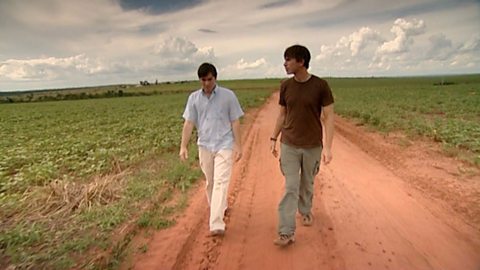Liz Bonnin introduces a video clip examining how physical processes, including ice and glaciers, have shaped the landscape of the Yorkshire Dales.
LIZ BONNIN: Hi, Iβm Liz Bonnin. Iβm looking into physical geography, but whereas a geologist might dig around some rock formations, Iβve been digging into the ΒιΆΉΤΌΕΔβs vast archives to uncover programmes packed with inspiring information.
And this one has got almost everything. Spectacular views of the British countryside, locations that featured in the Harry Potter series, strange rock formations, rare plants, a place loads of you will recognise from school trips, fascinating facts and on top of that, theyβve thrown in comedian, Hugh Dennis, and wildlife presenter, Julia Bradbury, who get things started with a stroll atop a vast limestone patio in the Yorkshire Dalesβ¦
JULIA BRADBURY: Set foot on it, and itβs one weird place. Almost otherworldly.
Ooh, did you hear that?
I feel as though Iβm walking along the spine of a dinosaur.
This spot is so weird, they filmed a scene from Harry Potter here. So how has such a mysterious place come to be?
This concoction of weirdly-shaped slabs and cracks would once have been a flat expanse of rock. But over the years, surface water has nibbled away at the limestone, leaving this incredible pattern.
The pieces of this limestone pavement, as itβs called, have old Yorkshire names.
The blocks are called clints. And the gaps are known as grikes.
But the most curious thing is whatβs hidden down in the grikes. Meet Professor Cynthia Burek, a geo-conservationist, whoβs fascinated by this unusual rocky habitat.
Limestone pavements are pretty mysterious places, arenβt they?
CYNTHIA BUREK: Yes, they are full of surprises and mysteries.
JULIA BRADBURY: Remarkably these cracks are teeming with plant life thatβs extremely rare in Britain.
CYNTHIA BUREK: Down in the grikes we have a very shady, a very humid sort of environment. Microclimate, if you will. And we have shade-tolerant plants down there. Fernsβ¦
JULIA BRADBURY: Youβre making it sound quite nice.
CYNTHIA BUREK: Itβs a bit narrow to get down there! Itβs a real surprise for people when visitors come up here. They say, βOh my goodness, look. Look at all these ferns. These hartβs tongue fern and the maidenhair spleenwort.
JULIA BRADBURY: Just lovely, lovely names!
CYNTHIA BUREK: Yes.
JULIA BRADBURY: But thereβs a puzzle. These are plants youβd expect to see in shady woodland. Not here. How did they get here then? Well theyβre a clue that not so long ago this all would have looked completely different. It was a thick forest.
CYNTHIA BUREK: So this would originally have been ancient woodland. The whole thing, but the only place we find the woodland now is down the grikes. This relic woodland flora which used to be everywhere. Thatβs what makes this landscape, this feature, so special.
JULIA BRADBURY: The woodland that once covered the uplands of Yorkshire were stripped back to bare limestone by our ancient ancestors and their grazing animals. It took thousands of years.
LIZ BONNIN: The limestone is the remains of tiny creatures and plants that died and sank to the bottom of a tropical sea, that covered the Yorkshire Dales, 330 million years ago. Now over millions of years, vast amounts of sea life got compressed into stone, creating a staggeringly thick bed of rock.
Later in the last ice age, glaciers swept right across Yorkshire, scouring the rock surface to leave those huge flat areas, and below that limestone pavement lies a place with its own dramatic story. A place that Hugh Dennis is particularly fond of, Malham Coveβ¦
HUGH DENNIS: Itβs a fantastic cliff. Itβs about 200 feet I should think, top to bottom. Itβs absolutely sheer. I think I must be feeling exactly what a spider feels like when itβs trapped at the bottom of a bath. They havenβt looked after it very well though, it could do with some limescale removing. Look at the staining on that.
Essentially youβre looking at one massive pile of dead coral and shellfish. And thereβs the same amount again below ground. But wait and see what else happened here.
The sea bed that would turn into limestone began experiencing earthquakes. Over millions of years, a fault deep under the sea floor made part of it drop.
Eventually the sea dried up and there was desert. But the place was under constant change. In fact 300 million years of drama later, it was even covered in ice, which melted sending trillions of tons of water cascading over the drop in the ground.
It would have been like Yorkshireβs own Niagara Falls, sculpting and eroding Malham Cove into the place I love today.
LIZ BONNIN: Now thatβs what I call an epic clip! Sometimes geography rocks!
Wildlife presenter Julia Bradbury visits Malham Cove and explains how the landscape has changed - going from ancient woodland to the limestone pavement that is there today.
How the limestone pavement is formed, including the significance of glaciers, is explained.
This short film includes an animation of how the seabed was changed by a tectonic shift, before turning into desert, being covered in ice and, million of years later, ending up as the landscape that we see today.
This short film is from the ΒιΆΉΤΌΕΔ series, Physical Geography with Liz Bonnin.
Teacher Notes
As many classes study this area and this formation, this short film can be used to apply the study of limestone and glacial erosion to the classroom.
Students could watch this clip either before or after they study and see just how spectacular the landscape is.
Curriculum Notes
This topic appears in geography at KS3 and KS4 / GCSE in England, Wales and Northern Ireland and National 4/5 in Scotland.
More geography clips with Liz Bonnin:
What is the water cycle? video
Iain Stewart describes the water cycle and explains that water is constantly suspended in the atmosphere, yet we only notice it when it falls as rain.
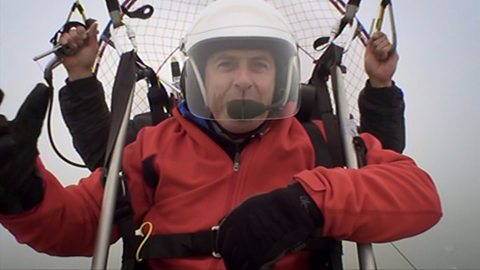
How does a river change as it travels downstream? video
Liz Bonnin introduces a ΒιΆΉΤΌΕΔ archive clip of Sir David Attenborough as he follows the Amazon River downstream.

The erosion of the Grand Canyon. video
Liz Bonnin introduces the Grand Canyon with its complex and very ancient geology.
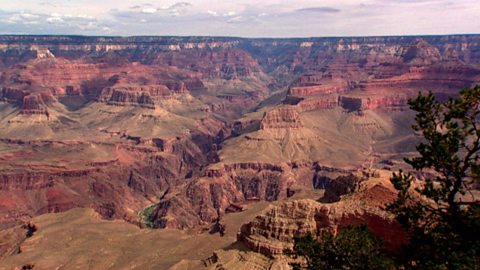
What coastal management techniques are being used on Hayling Island? video
This short film introduces the coastal management techniques used on Hayling Island in Hampshire.
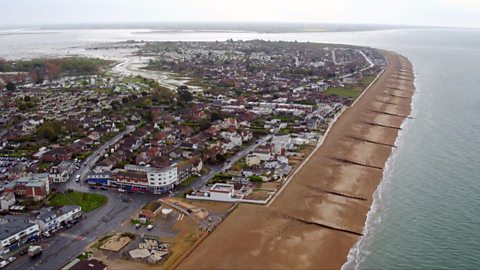
What is a βspitβ and how does it form through longshore drift? video
Presenter Katie Knapman explains how a spit forms through longshore drift and is a dynamic feature- constantly changing the coastline.

The geological significance of the Jurassic Coast. video
A look at the Jurassic coastline and its geological significance with rocks spanning the Cretaceous, Jurassic and Triassic periods.
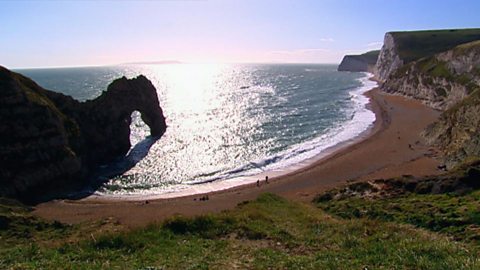
What does the North Norfolk coastline tell us about how glaciation shaped Britain? video
Presenter and biologist Alice Roberts explains how Britain used to be connected to Europe via a land-bridge but has changed with sea-level rise since the last Ice Age.
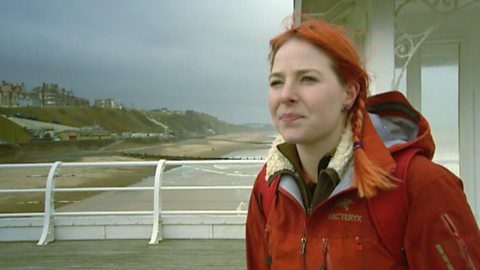
Glaciation of the Northern Hemisphere. video
Presenter Iain Stewart explains the glaciation of the Northern Hemisphere, looking at the El Capitan rock face.
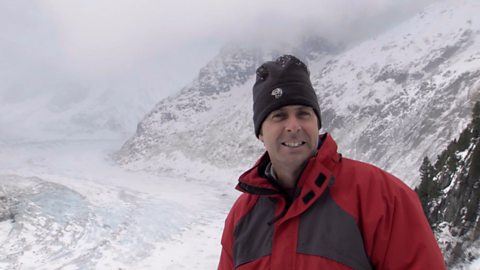
What evidence is there for a changing climate in the UK? video
Countryfile presenter Tom Heap introduces the idea that the UK climate might be changing, with increased droughts, increased summer temperatures but wetter winters.
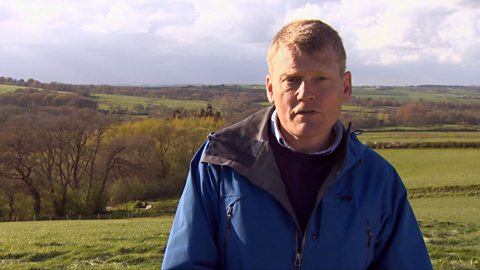
The continued impact of plate tectonics on our oceans. video
A look at how our oceans are constantly changing due to the underlying plate tectonics.
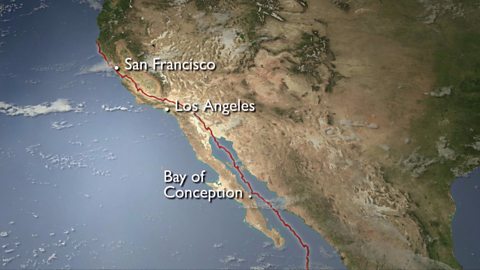
What can Anglesey tell us about the plate tectonics of Britain? video
Presenter Nick Crane uses a map to compare the geology of Anglesey to that of the rest of Britain - highlighting the diversity of rock types.

Deforestation and soya growth in Paraguay. video
Simon Reeves visits Paraguay to consider the deforestation that has occurred to grow soy and the challenge of conversation vs exploitation.
